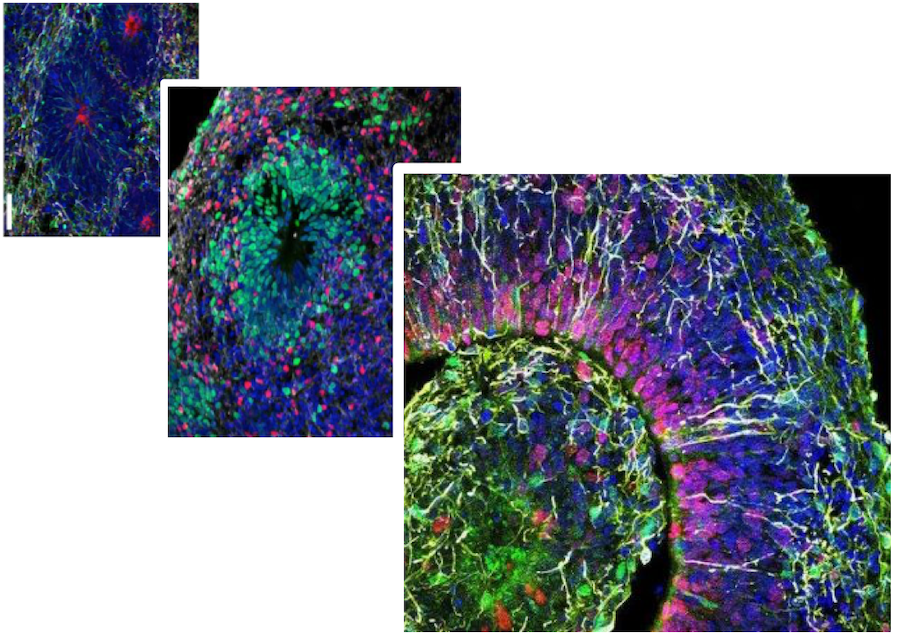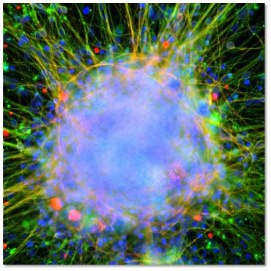Stem Cell Studies on Autism

Research Conducted by ACE
Using human induced pluripotent stem cells (hiPSC cells) derived from skin cells
The Autism Center of Excellence (ACE) is conducting studies of a special type of stem cell called human induced pluripotent stem cells (hiPSC cells), which are derived from the skin of living autistic children and adults. These studies aim to shed light on the underlying genetic, molecular and neural mechanisms of autism spectrum disorder (ASD).
ACE plans to use hiPSC cells to help understand the mechanisms that may underlie early brain over growth as well as the mechanisms that distinguish ASD children with good clinical outcomes from those with poor outcomes. Leading this research are:
Eric Courchesne, ACE co-director
Alysson Muotri, stem cell world leader
Nathan Lewis, bioengineering expert
What are Stem Cells?
All stem cells have two basic characteristics: they are capable of self-renewal and differentiation.
-
Self-renewal describes the ability of one stem cell to make more of itself: one stem cell quickly becomes two, which becomes four and then eight, etc.
-
Differentiation describes the ability of a stem cell to mature into an entirely different cell type: it stops being a stem cell and starts being something else.
In the adult human body, several types of stem cells exist. The best-described type of adult stem cell lives in the bone marrow and can differentiate into all the cell types of the blood (hematopoietic stem cells). This is the type of stem cell transplanted in the treatment of leukemia. Another adult stem cell lives in the intestine and is responsible for replacing the lining of the gut every seven days. A third adult stem cell lives in the skin and is responsible for wound healing and hair growth.
Adult stem cells also reside in the hippocampus of the brain where they are believed to contribute to learning and memory.
The important thing to note about all of these adult stem cells is that they are lineage restricted. Hematopoietic stem cells can only make blood cells. Intestinal stem cells can only make gut cells. Skin stem cells can only make skin and hair.
None of these stem cells can be used to make brain cells for our experiments. Brain stem cells do make brain cells, but they cannot be safely removed from patients with ASD. It is only by generating hiPSCs from skin biopsies that scientists can now generate vast amounts of brain cells with which to study ASD.
Generating neurons in the lab from ASD patients
In 2006, scientists in Japan discovered that skin cells could be changed ("reprogrammed") into stem cells that are capable of making every type of cell found in the body, including brain cells ("neurons").
This means that from just a tiny skin sample from our ASD patients, we can generate limitless brain cells ("neurons") with which to study this disorder. Also, by taking skin samples from both patients with ASD and without, we can determine how the brain cells from the ASD patients are different.
We hope that understanding how brain cells with ASD are different will help us eventually identify drugs that help reverse these effects.
Using hiPSC Cells in Research
What are hiPSCs?
hiPSCs stands for "human induced pluripotent stem cells." These are a type of stem cell that scientists can generate in the laboratory from skin cells.
-
hiPSCs are "induced" because scientists generate them by turning on stem cell genes in skin cells. Slowly, over the course of about one month, these stem cell genes turn the skin cells into stem cells.
-
hiPSCs are "pluripotent" because they can be directed to give rise to every type of cell found in the human body. These cells can be grown indefinitely in the laboratory, meaning that they can generate near limitless numbers of any cell type for scientific experiments. For the first time, using hiPSCs, we have enough live human brain cells afflicted by ASD to comprehensively study the structural and functional characteristics of these cells.
Benefits of using hiPSC cells
Skin cells ("fibroblasts") are only capable of growing in the laboratory for a few months. They cannot make brain cells and do not express brain genes. Scientists use viruses to deliver the four stem cell genes, OCT4, SOX2, KLF4 and cMYC, into the skin cells. Remarkably, turning on just these four stem cell genes is sufficient to completely change the identity of the skin cells.
hiPSCs can be grown indefinitely in the laboratory. Scientists predict that they are capable of making every cell type in the human body, and can be routinely turned ("differentiated") into beating heart cells, electrically active brain cells and even blood cells. It takes about one month to generate a single cluster ("colony") of hiPSCs from skin cells. It takes another 2-3 months to expand this single colony into a sufficient number of hiPSCs to begin making neurons.
It can be difficult to grow hiPSCs in the laboratory. The cells need to be kept in special incubators maintained at exactly 37°C and with 5% carbon dioxide to mimic conditions in the body. Researchers need to change the medium that the cells are fed every single day. This media is carefully pH balanced at 7.3-7.6 to maintain optimal growth and contains all the amino acids and sugars that the hiPSCs need to grow and survive.It took many years for scientists to optimize the growth conditions for hiPSCs. Now researchers are careful to remove from the medium any growth factors that might induce the hiPSCs to differentiate prematurely or into any cell type other than brain cells.
hiPSC derived brain cells from ASD patients may have too few or too many connections
From our hiPSCs, we can generate brain cells from patients with ASD. By taking extremely high magnification images (up to 1200x magnification) we can count the number of connections between brain cells and see if this is affected in ASD.
|
Image courtesy of Fred Gage Laboratory. |
hiPSC derived brain cells from ASD patients may undergo too much replication during maturation
Eric Courchesne and ACE colleagues have already shown that the majority of autistic children have brain volumes larger than the normal average by 2 to 4 years of age based on both MRI (Courchesne et al., 2001) and head circumference data (Courchesne et al., 2003). This brain size increase coincides with the onset of autistic symptoms but occurs through an unknown mechanism.
The ACE stem cell team will test whether there is excessive cellular replication as hiPSCs from ASD patients are differentiated into neurons in the laboratory.
hiPSC derived brain cells from ASD patients may have aberrant activity by some genes. Every feature and function of a cell is regulated by the expression of genes. By understanding which genes are undergoing aberrant expression in neurons from these patients, we may come to better understand what causes ASD. By generating large numbers of living human control and ASD neurons, we can complete experiments to determine which genes, if any, show abnormal expression (either too high or too low) in ASD.

 Neurons differentiated from hiPSCs from a patient with ASD. The axons of the neurons are labeled in green, the dendrites are labeled in red and the nuclei in blue. 100x magnification.
Neurons differentiated from hiPSCs from a patient with ASD. The axons of the neurons are labeled in green, the dendrites are labeled in red and the nuclei in blue. 100x magnification.